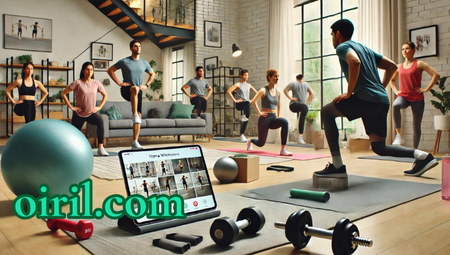As fitness enthusiasts and beginners alike strive for a healthier lifestyle, home workouts have become a popular and convenient way to achieve fitness goals without the need for a gym membership. Whether you’re a beginner just starting your fitness journey or an experienced athlete looking for an at-home routine, effective workouts can be tailored to all levels. With minimal equipment and some consistency, you can make progress right from your living room. This guide will cover a range of workouts suitable for every fitness level, from beginner to advanced, with tips to ensure you’re getting the most out of each session.
Why Choose Home Workouts?
Home workouts offer flexibility, cost-effectiveness, and accessibility that suit a wide range of lifestyles. Here are some of the biggest advantages:
- Convenience: With no commute to the gym, you save time and can exercise whenever you choose.
- Cost-Effective: No gym fees mean more savings, especially if you’re investing in basic equipment.
- Privacy and Comfort: Some people find gyms intimidating. Working out at home allows you to exercise in a familiar environment at your own pace.
- Adaptable Space and Equipment: With a few essentials—like a mat, dumbbells, or resistance bands—you can create versatile workouts that rival any gym session.
Getting Started Key Principles for Home Workouts
Whether you’re a novice or a pro, sticking to some fundamental fitness principles will make a big difference in the effectiveness of your home workouts.
Set Clear Goals: Define what you want to achieve. Whether it’s building muscle, improving endurance, losing weight, or increasing flexibility, having clear objectives will shape your routine.
Focus on Form: Poor form can lead to injuries, so ensure each movement is performed correctly. Use mirrors or record yourself to monitor your form.
Track Your Progress: Keep a workout journal or use an app to monitor your reps, sets, and overall progress.
Stay Consistent: Regularity is key. Design a weekly workout schedule, even if you start with just three sessions a week.
Warm Up and Cool Down: Never skip warming up before and stretching after each session. This reduces injury risk and helps with recovery.
Home Workouts for Beginners
If you’re new to fitness or returning after a break, it’s important to start with simple movements that build foundational strength, flexibility, and endurance. Here’s a basic home workout routine for beginners.
Sample Beginner Workout (3 Times per Week)
Bodyweight Squats: 2 sets of 12-15 reps
Targets the legs and glutes, helps improve lower body strength.
Knee Push-Ups: 2 sets of 10-12 reps
Engages the chest, shoulders, and triceps, focusing on upper body strength.
Glute Bridges: 3 sets of 12 reps
Strengthens glutes and hamstrings, great for lower body activation.
Bird-Dog: 2 sets of 10-12 reps (each side)
Enhances core stability and strengthens lower back muscles.
Plank Hold: 2 sets of 20-30 seconds
Works the entire core, improves stability and posture.
Mountain Climbers: 2 sets of 30 seconds
Adds a cardiovascular element, increasing heart rate and boosting endurance.
Intermediate Home Workouts
Intermediate routines can increase intensity and incorporate a wider range of movements. Adding weights or resistance bands at this level can help build more muscle and strength.
Sample Intermediate Workout (3-4 Times per Week)
Dumbbell Goblet Squats: 3 sets of 12 reps
Increases lower body strength and adds resistance with dumbbells.
Push-Ups: 3 sets of 10-15 reps
Builds upper body strength and tones the chest, shoulders, and triceps.
Walking Lunges: 3 sets of 12 reps per leg
Targets quads, glutes, and hamstrings, improves balance and stability.
Dumbbell Rows: 3 sets of 10 reps per arm
Works the back and biceps, improving posture and upper body strength.
Russian Twists: 3 sets of 15 reps per side
Engages the obliques, improves core stability and rotational strength.
Bicycle Crunches: 3 sets of 20 reps per side
Targets the core, focusing on the abs and obliques.
Burpees: 2 sets of 10 reps
Increases cardiovascular endurance, full-body strength, and coordination.
Advanced Home Workouts
Advanced workouts are designed for individuals with a solid fitness foundation. At this level, high-intensity training and complex exercises will challenge endurance, strength, and agility.
Sample Advanced Workout (4-5 Times per Week)
Pistol Squats: 3 sets of 8 reps per leg
Requires balance, flexibility, and lower body strength.
Handstand Push-Ups (or Pike Push-Ups): 3 sets of 10 reps
Targets the shoulders, arms, and core, providing a challenging upper body workout.
Bulgarian Split Squats with Dumbbells: 3 sets of 10 reps per leg
Strengthens legs and glutes with added resistance and a focus on balance.
Weighted Pull-Ups: 3 sets of 8 reps
Builds back strength, enhances upper body muscle tone.
Kettlebell Swings: 3 sets of 15 reps
Full-body exercise targeting the core, glutes, and hamstrings.
V-Ups: 3 sets of 15 reps
Intense core exercise that challenges the abs and overall stability.
Burpee-to-Box Jumps: 3 sets of 10 reps
High-intensity move that combines cardiovascular fitness with lower body power.
Tips for Making the Most of Your Home Workouts
Invest in Versatile Equipment: A few adjustable dumbbells, resistance bands, a yoga mat, and a stability ball can transform your home workout.
Incorporate HIIT Sessions: High-Intensity Interval Training (HIIT) boosts cardiovascular endurance and burns calories in a shorter time. Try 20 seconds of intense effort followed by 10 seconds of rest for each exercise.
Use Online Resources and Apps: Platforms like YouTube, and apps like Nike Training Club or MyFitnessPal, offer guided workout videos and track progress.
Combine Strength and Cardio Workouts: For a balanced routine, alternate strength-focused days with cardio-based exercises, such as jumping rope, bodyweight circuits, or dance cardio.
Set Up a Dedicated Workout Space: Even a small area can become your workout zone. Keep it organized and free of distractions.
Avoiding Common Home Workout Mistakes
While home workouts are convenient, they can lead to some pitfalls. Here are a few to watch out for:
- Skipping Warm-Ups or Cool-Downs: Without proper warm-up, you risk injuries. Cooling down helps with muscle recovery.
- Neglecting Proper Form: Focus on quality over quantity. Bad form leads to injuries and reduces workout effectiveness.
- Underestimating Rest: Just because you’re at home doesn’t mean you should overtrain. Muscles need rest to grow.
- Sticking to One Routine Too Long: Progress requires variety. Keep challenging your body by switching up routines every 4-6 weeks.
The Power of Consistency and Patience
Home workouts require discipline and dedication. Staying motivated may be harder without the energy of a gym, but the flexibility and convenience they offer make it easier to integrate fitness into daily life. Set realistic goals, keep a positive mindset, and enjoy the process of growing stronger and healthier.
Home workouts are effective for every fitness level, offering endless options for strength, cardio, flexibility, and balance training. With the right approach, tailored routines, and consistency, home workouts can lead to impressive fitness gains.




